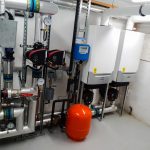Cast Aluminium or Stainless Steel Heat Exchangers. Which is better?
Aluminium or Stainless. Does it make a difference?
We receive a lot of requests from clients for specifically stainless-steel heat exchangers in their new boilers as they are considered by some to be more durable and last longer.
The reality is, that if the water going through the boiler is not properly treated, then the heat exchanger is going to fail at some point, whatever metal the heat exchanger is made from.
Whether the heat exchanger is stainless steel or cast aluminium if the system is not treated with the correct amount of inhibitor then the water will slowly start to erode the metal and you will eventually find that you have a very expensive leak in your boiler. The heat exchanger makes up the bulk of a modern condensing boiler and in many cases if the heat exchanger fails a complete new boiler is likely more cost-effective than just replacing the heat exchanger.
Stainless steel is a more durable material than cast aluminium and should theoretically last longer but if the water has not been treated, especially where a new boiler is connected to old pipework or freshwater is regularly added to the system, then it’s unlikely to last even two weeks longer than an aluminium heat exchanger.
The main reason a stainless-steel heat exchanger does not last longer is that it cannot be made without weld spots. Whereas, a cast aluminium heat exchanger can be moulded as one lump so there are no weald spots. Weald spots create a weak point in the heat exchanger and like a chain, it’s only as strong as its weakest link. If you find a stainless-steel heat exchanger leaking 9 times out of 10 it will be at one of these weald spots.
Aluminium being cast in one also means the waterways are generally much larger than that of stainless steel. This means that should debris get into the heat exchanger it has more of a chance of getting out the other end without damaging the heat exchanger. In smaller waterways, the debris can easily get stuck and block the heat exchanger. This will at a minimum, greatly reduce the efficiency of your boiler.
This brings us to the point of efficiencies. Cast aluminium is a slightly better conductor of heat than steel. This means that your boiler would be slightly more efficient than a stainless-steel heat exchanger. However, this difference is very marginal and the potential savings are barely noticeable. The quality of the commissioning is likely to make more difference to the efficiencies than the material of the heat exchanger.
Aluminium is lighter than steel. This is helpful if the installer will need to get a large boiler into a plant room with difficult access. A lot of boilers particularly in schools and churches are located in a basement and at Cowley, we have a lot of experience with the difficulties of getting very heavy boilers down slippery, narrow steps. A few kilograms can sometimes be the difference between standard lifting gear or a small crane.
Our recommendation particularly when replacing a boiler is to install a stand-alone heat exchanger to separate the existing system from the new boiler/s. This will provide hydraulic separation and mean that no system water which is going through older pipework and likely contains dirt and debris, goes through the new boilers. This completely protects the new boilers from the older pipework. Should the heat secondary heat exchanger fail this can be easily replaced at a fraction of the cost of a new boiler heat exchanger.
Build quality is generally more important to look for when choosing a new boiler and you should go by recommendations. A mechanical consultant or contractor usually has preferred brands that they would recommend and are reliable.






